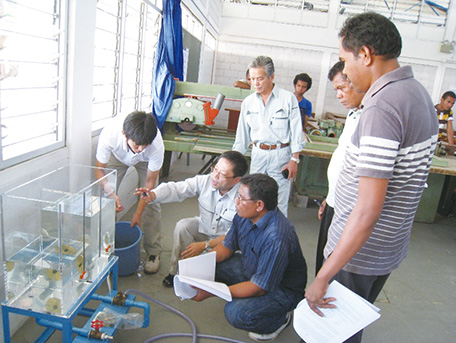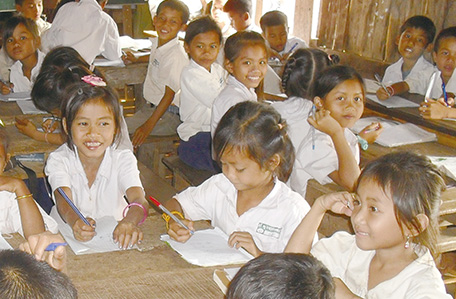Japan's Official Development Assistance White Paper 2013
Section 2 Human Resource Development: Japan’s Cooperation which Forms the Foundation of Nation-Building
For the sustainable development and stability of developing countries, fostering human resources who will play an important role in the development process is crucial as the foundation of nation-building. Japan, in addition to infrastructure development assistance, has proactively supported human resource development as “investment in the future.” Human resource development cooperation in various sectors via ODA has not only contributed to the development of developing countries, but also to strengthening the friendship and mutual understanding between Japan and developing countries.
In the following examples of Japan’s technical cooperation in Southeast Asia for human resource development – one of Japan’s top priorities, the efforts for fostering and utilizing human resources are recapped.

Ms. Watanabe, a JOCV (occupational therapist) (front) who has been dispatched to a hospital in Ho Chi Minh City, Viet Nam. Looking at the X-ray, she and her colleague consult each other about the treatment method. (Photo: Yuki Kato / JICA)
■ Timor Leste, “Capacity Development of the Faculty of Engineering, Science and Technology, the National University of Timor-Leste”
The National University of Timor-Leste (UNTL), which opened in November 2000, is the only public institution of higher education in Timor-Leste. Plagued by many years of political turmoil, educational institutions suffered from significant deterioration. At UNTL’s inception, the faculty lacked the necessary teaching knowledge, and more than 70% of the school’s buildings and educational equipment were damaged due to the turmoil accompanying independence in 1999. Against this backdrop, Japan began extending assistance to UNTL’s Faculty of Engineering in 2001, and implemented various cooperation, including the installation of educational equipment, dispatch of experts, and faculty training.
Following-up on the assistance extended continuously since 2001, this project was initiated in 2011 to ensure the provision of high quality engineering education under appropriate management and operations. In 2013, the third year of the project, a teaching curriculum was developed, the number of faculty with a master’s degree increased from 24 to 44 people, and research activities gained further momentum.
As indicated by Timor-Leste’s Strategic Development Plan established in 2011, which states that “The government will strengthen institutions of higher education beginning with UNTL to train human resources who will be the future leaders of the country,” extraordinary expectations are attached to the Faculty of Engineering at UNTL that fosters human resources who are responsible for the future of technology. This project, designed to improve the education and research capabilities of the Faculty of Engineering, is expected to contribute to agriculture, the country’s current primary industry, as well as to the development and improvement of economic and industry bases over the country’s future by producing promising human resources who are equipped with advanced technologies.

Local staff in Timor-Leste receiving an explanation on the experiment apparatus from Japanese experts (Photo: JICA)
■ Laos, “Supporting Community Initiatives for Primary Education Development in the Southern Provinces”
Inhabited by many ethnic minorities, the southern region of Laos has a high level of poverty and little development progress. The Government of Laos carries out activities in a variety of sectors to fundamentally solve the problem of poverty in this region, and identifies the expansion and improvement of education as one of its priorities.
To support the activities of the Government of Laos, Japan began extending cooperation for primary education in this region in 2007. The goal of the project is to improve primary school education with local residents’ participation in the management of schools. In this region where the school enrollment rate is lower than in other regions, the issues facing school education are addressed through the participation of the local community, including parents, guardians, and temples, with residents themselves brainstorming and proposing solutions. There are various reasons for which children cannot or continue to attend schools. Some reasons are attributable to schools, such as problems of shortage of and improper school buildings and classrooms, shortage of teachers, and quality of teachers, while some reasons are attributable to problems, such as a lack of understanding or poverty of families. This project demonstrated that in addition to the efforts by schools, the community’s mutual support has substantial impact on children’s school attendance and continuation, and shed light on which field activities are effective. Japan, by means of dispatching experts and supplying equipment, among other activities, supported the project by encouraging schools and residents to participate. As a result, the average net school attendance rate for the relevant schools improved dramatically from about 73% to nearly 100%.
As a follow-up to Phase 1 of the project implemented from 2007, Phase 2 started in 2012. In assessing the different reasons by village and household and finding clues for resolving the problems, local governments, including districts and provinces, play a crucial role. Phase 2 intends to understand the situation of each school, and develop local government services to provide the necessary support to those schools in need of assistance. Schools, while receiving support from the community and local governments, strive to understand the problems they themselves face and make improvements so that they can make continuous enhancements on their own. Japan assists these efforts by dispatching experts and implementing trainings.
Japan’s cooperation is expected to improve access to education in the southern region of Laos and enhance the quality of education. At the same time, the strengthening of the capacities of the local community and the promotion of human resource development are expected to lead to poverty reduction and growth in this region.

Children in Laos learning at a classroom (Photo: JICA)
